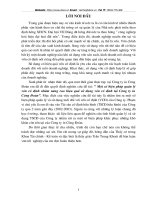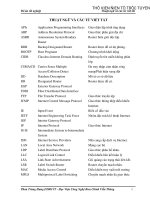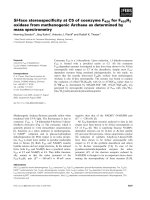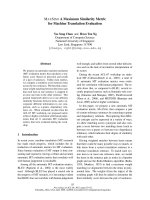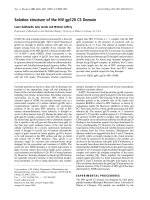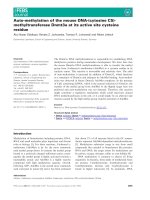Updated im c5 vdbdsbadvavasv
Bạn đang xem bản rút gọn của tài liệu. Xem và tải ngay bản đầy đủ của tài liệu tại đây (15.44 MB, 32 trang )
CHAPTER 5
PRODUCT DECISION
VU THN
Content
1. Product policy
2. Standardization vs adaptation
3. Packaging
4. Brand image
Introduction
• Options across product mix
• Global v local branding a major decision
• Rationalisation in MNEs – reducing number of brands
• Global brands - transcend countries and culture to create strong
relationships with consumers in multiple countries.
• Rise of emerging market brands
• Complex decision-making
1. Product policy
1.1 product planning and development
1.2 product strategy.
Should the company keep a commitment to its existing product mix as the
products reach maturity?
How strongly should the firm follow a strategy of new product
acquisition/innovation?
What are the organizational requirements for following each of the above
approaches?
1.1 Product planning and development
Product Component Model
1. The physical product core;
2. The product package;
3. Support services.
A product (or service) is “the sum of all the physical
and psychological satisfactions that the buyer (or
user) receives as a result of the purchase and/or use
of a product”.
1.2 Product planning and development
Forms of product development:
1. new product development or addition;
2. changes in existing products;
3. finding new uses for existing products;
4. product elimination.
1.2 Product planning and development
1.2.1 New product
• export domestic products (is easy to implement, at least initially, and may represent a
relatively low-cost approach)
• acquire a firm (has products for which there are potential or existing overseas
markets)
• copying products (developed successfully by others)
• internal product development (an evolutionary process consisting of a number of
stages)
Internal development of new products
• location of R&D facilities of
firms;
• the process of screening new
product ideas;
• the diffusion of new product
innovations;
• quality management.
New product decision process
1.2.1.1 Location of R&D
Home market firms
Host market firms
Worldwide market firms
Important criteria
for considering an
overseas R&D
location
1. Proximity to operations
2. Availability of universities
1. Proximity to markets
2. Concept of overseas
operations as full-scale
business entities
1. Availability of pockets of skills
in particular technical areas
2. Access to foreign scientific and
technical communities
3. Availability of adequate
infrastructure and universities
Important criteria
for not considering
overseas R&D
locations
1. Products sold in the
developing countries are not
sophisticated
2. Lack of qualified scientists
and engineers
3. Economics of centralized R&D
1. Increasing costs of
doing R&D overseas
2. Economics of
centralized R&D
1. Economics of centralized R&D
2. Difficulties in assembling R&D
teams
Important criteria for considering overseas R&D locations
“Fashion is more and more global. It doesn’t belong anymore to the French. Or even to
the Italians. I’m a global person: I spend two months in Como [in the Italian Alps], one
month in Milan, two months in Miami. I just don’t think any longer in terms of nationality.
Calvin Klein is American, [but he] makes things in Italy. The French houses all have
English designers now, and women are going global”
1.2.1.2 Screening ideas
Conjunctive model uses all evaluative criteria. The product, in order to proceed for further
consideration, must meet or exceed a minimum value for each of the criteria used.
Disjunctive model based on accepting a product that exceeds specified levels on one or a few key
criteria, regardless of its score on the others.
Lexicographic model based on ranking the evaluation criteria in terms of their perceived importance.
New product ideas are compared criterion by criterion until there is a superior idea. This may occur after
the first criterion or after many criteria.
Linear compensatory model assigns differential importance weights to each criterion and then
determines a summated evaluation score for each product. Further analysis is conducted either on all
products exceeding a minimum score or the one product scoring highest. This is perhaps the most widely
used approach.
1.2.1.3 Innovation and diffusion of products
The center-for-global
innovation process
The local-for-local
innovation process
The local-for-global
innovation process
The parent company/
- created and
- emerge as local-for-
- created by pooling
a central facility (the
implemented by a
local innovations, are
the resources and
corporate R&D
national subsidiary
subsequently found to
capabilities of many
laboratory) – creates
entirely at the local
be applicable in
different
a new product for
level
multiple locations, and
organizational units to
worldwide use
- all tasks are all
are diffused to other
an emerging global
carried out within the
organizational units
opportunity.
subsidiary
within the multinational
corporation
The global-for-global
innovation process
1.2.1.2 Quality management
9000
● the customer’s quality requirements;
● applicable regulatory requirements,
while aiming to
● enhance customer satisfaction;
● achieve continual improvement of its
performance in pursuit of these
objectives.
● minimize harmful effects on the
environment caused by its activities,
● continual improvement of its
environmental performance.
1.2.2 Changes in existing products
Extend PLC by making modifications (standardization or adaptation)
1.2.3 Finding new uses for existing products
● Is there a related application (e.g., an insecticide for ants may be used for bees in Latin
America)?
● A product sold to women may be sold to men and vice versa (such as deodorants).
● Can the product be used differently when used with another product (e.g., an after-shave lotion
used as a pre-shave lotion with an electric razor)?
● Consumer products may have an industrial market and vice versa (such as garden tractors).
● Does the nature of attributes and/or ingredients suggest new uses (e.g., the light weight and
strength of balsa wood)?
1.2.4 Product elimination
- deleting ‘old’ or weak products
(disproportionately greater or lesser
percentage of sales and profits)
- when to withdraw it from foreign
markets and, further, when to
eliminate it from the company’s
product line.
- the set of strategies for the
synchronization of old product deletion
with entry of a new product is known
as product phasing
The phasing continuity matrix
1.3 Product portfolio
BCG portfolio matrix
2. Standardization vs adaptation
Reasons for standardization or adaptation (research produced)
Example
Product Adaptation
Sony TV
McDonald’s
Levi jeans
Coca-Cola
KFC
Market requirements and product characteristics
Voltage, broadcast standard
Menu, décor of restaurant
Size mix, fabric, cut
Brand name (China), package
Menu
3. Packaging
V – Visibility : the package must be easily distinguished from the visual competition.
I – Information : the package must quickly communicate the nature of its contents.
E – Emotional impact : the design must create favorable impressions in the mind of
the consumer.
W – Workability : the package must function as protection and must also be efficient
in home use.
3.1 The benefits of standardization in
packaging
01
Reduction of dimensions to a few standard sizes facilitates the machine packing of
merchandise
02
Standardized package sizes reduce inventory investment in packaging materials, and facilitate
mass production of the fewer types of packages and shipping boxes
03
Standardization permits full utilization of storage space at the factory and all levels of
distribution
04
Uniform package dimensions permit a balanced format for display and for self-service
selling
05
Standardized sizes simplify, expedite, and cut the cost of handling and shipping.
4. Brand image
“A brand is anything that identifies a seller’s goods or services and
distinguishes them from others”
“A trademark is a brand, or part of a brand, which is protected (in that
others may not use it) by law”
A brand indicates:
- the origin of the product
- the assurance of quality;
- warranty
4. Brand equity
4.1 Country of Origin Effect
Country-of-origin effect (COE ) can be defined as any influence that the country of
manufacture, assembly, or design has on a consumer’s positive or negative perception
of a product.
•
Country of design and manufacture play a role
•
Brand name can convey origin perceptions
•
May communicate positive or negative perception of product based on cultural
stereotypes
•
Can provide a cue when unfamiliar with brand
•
Some countries associated with specific products
French Perfume/ Swiss Watches/ German cars/ Italian shoes/ French fashion/ etc.
4.2 Branding decisions
•
selecting a good brand
•
determining how many brands should be in the company’s product line.
Factors bearing brands decisions
•
customer needs
•
distribution and promotion methods to be used
•
competitive market structure
•
economies of scale in production and distribution
•
legal constraints
•
operational structures.
Private label?
Single market, multiple brands?
Multiple markets & local brands?
4.3 Local Branding
CULTURAL BARRIERS
- name has unfortunate meaning in linguistic or cultural context
- Pronunciation difficult e.g. Kellogg’s Frosted Flakes and Cocoa
Krispies difficult to say in Brazil’
ASPECTS
- In LDC’s domestic products may be viewed as inferior
- In developed countries domestic products have positive perception
- May enable international brands to compete successfully with cheaper local brands
- Problems of anti-western or anti-American feeling?
